Cocoon Rattles made by Native Californians appear on the cover of Shuttle Spindle and Dyepot- issue 101- winter 94/95. The photographs give clues as to how to construct the rattle. The article describes the materials used...and why. A rattle is a personal possession, it can only have significance for the person who uses it. The rattles were believed to be very powerful, not everyone possessed one...and they were used for various purposes.
On paper I design my rattle based on the photos and other information I find on the internet. "Maa-Yoy" is the Eastern Pomo name for both cocoon and rattle. Native American Rattles represent three kingdoms. Animal. Mineral. and Plant.
...I gather my materials, they are symbolic. Cocoon rattles make a soft shusshing sound, thought to clear ones mind. I try to include the same sorts of materials used in traditional cocoon rattles..(seeds and seed beads, bits of seashell and egg shells and bones) I am fascinated to learn that traditional Pomo Indian rattles contained (among other things) grains of sand or gravel from ant hills, and seeds from the scat of certain powerful animals. Some people/cultures believed that because these seeds passed inside the animal, they possessed certain spiritual attributes or strength associated with that animal.
The base of the rattle was constructed from sticks that the porcupine chose from the hemlock. This is my favorite part of the rattle. You can still see the teeth marks where it stripped the bark.
In order to fill the cocoon, the "former resident" must first be extracted. Humm..what to do with THAT? Richard Peigler- in his article about Moth Cocoon Artifacts states: "There is some debate about whether or not native Californians ate the pupae from H. euryalus cocoons they collected, although it seems that routine entomophagy would be unlikely given the power most groups associated with the rattles made from the cocoons."
I tied the rattle with braided handspun flax and decorated the ends with porcupine quills and seed beads. thanks for keeping me inside the loop!

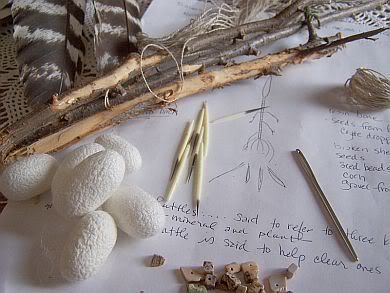
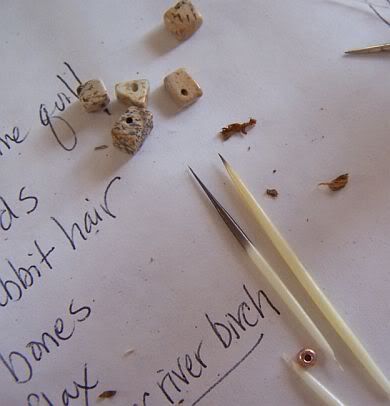
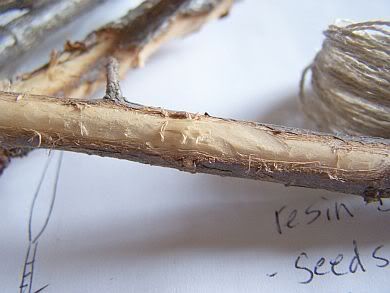
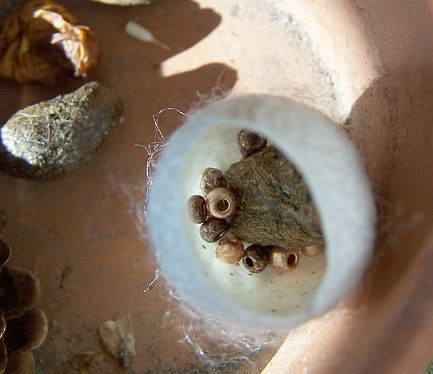

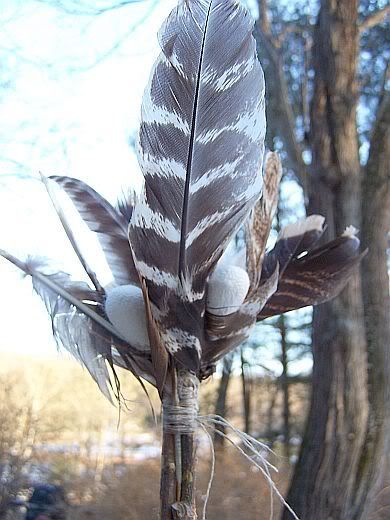


10 comments:
Well.
I love this post... and love the rattle and all the significance to it.
Of course, it worked...we got snow Monday. :-)
Very interesting and "kewl"!
Cyndy,
What a beautiful explanation of the process and the meaning behind the rattle! Re entomophagy, I don't know about the Pomo, but according to my friend Gary Paul Nabhan, an ethnobotanist in Arizona, the Tohono O'Odham eat the sphinx moth larvae (the roast them like popcorn) before they spin those great cocoons, and also when they cut open the cocoon for a rattle. I think I'd rather put the occupant outside for my local birds to eat though. ;~)
That is really, really neat. You should teach a class on this at John C. Campbell!
OMG Cyndy, this is a beautiful post. I have always admired the prayer sticks that are decorated with beads, feather etc. I wasn't aware of these rattles. I have so enjoyed your explaination and the pictures of this process. Beautiful outcome.
what an inspired idea! I love the story and the final product. Thanks for sharing.
I just love that! Its beautiful, and I'm sure its personal significance is even greater than simply how great it looks. Great work!
I love the rattle, and the thought and depth of meaning that went into it.
And how cool are your little 'reactions' buttons???????
Very interesting. Very well thought out. Very beautiful. Thanks for sharing.
Your thought process is wonderful and your final piece is highly worthy of great things and magic.
I have seen two native cocoon rattle/dance pieces in California, both were ankle bracelets with 2 or three rows of cocoons. They were not of course bombyx cocoons, but rather native probably tussah cocoons. One I think was in a museum in Santa Barbara (perhaps a basketry or native cultural museum. It has been about 7 yrs since I was there.
Great Blog!
Ercil
Post a Comment